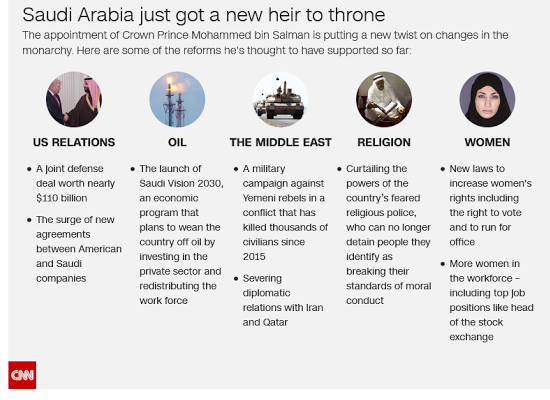It means that Trump has helped to make matters much worse by encouraging Saudi Arabia’s King Salman to elevate his 31-year-old son Mohammed bin Salman to first in line to the throne - in a “dramatic reordering of the kingdom’s line of succession that will have far-reaching consequences for the key US ally and the Middle East as a whole.”...
CNN, “What Saudi Arabia’s royal reshuffle means for the world”, 21 June 2017:
What does it mean for the US?
The key US priorities in the Middle East are stability and predictability, and the appointment of the relatively inexperienced Mohammed bin Salman is undoubtedly a shift away from that.
As defense minister, the prince has taken a hard line with Qatar, Iran and Yemen—and the US should expect to find itself increasingly caught up in the ebb and flow of the region’s ever-increasing political tensions.
The current diplomatic crisis between the Saudis and Qatar—Riyadh is trying to isolate Doha over claims that the latter supports terrorism—is a study in diplomatic tightrope-walking for the US.
Washington is publicly backing the Saudis over the spat—which has been led on the Saudi side by the new crown prince—while at the same time maintaining its large military base in Qatar.
Now, with a more gung-ho crown prince set to take charge, it is fair to assume that the Saudis will double down on its hardline positions on Qatar, Iran and the Yemen conflict.
What does it mean for Qatar?
In the short term, it’s hard to tell. The message to Qatar is clear: Expect more of the same. Mohammed bin Salman’s appointment means that the hard line taken by the Saudis is here to stay—and that no older, wiser voices are going to swoop in and moderate the stance any time soon.
What does it mean for Iran?
The move will further destabilize an already dangerously unstable situation.
Earlier in June, the Iranians pointed the finger at Saudi for a terror attack in their capital, Tehran. They then used this as a reason to fire missiles into Syria—a shot across the proverbial Saudi bow.
Tension between the two has been slowly building recently, and Mohammed bin Salman has taken a hard line against Iran. “We are a primary target for the Iranian regime,” he said in one recent interview. “We won’t wait for the battle to be in Saudi Arabia. Instead, we’ll work so that the battle is for them in Iran.”
Again, without more experienced voices around him, the new crown prince will feel emboldened to pursue his vision of a larger Sunni alliance, in which Saudi Arabia is the unchallenged leading power in the Middle East. This could lead to a dangerous miscalculation.
What does it mean for the Yemen conflict?
This is a conflict that Mohammed bin Salman has played a large part in—assisting the Yemeni forces in fighting off Iranian-backed Houthi rebels. In some respects, it is his war and he has to see it through.
But this is more than about saving face; Saudi stability is linked to Yemeni stability and, for that reason, the kingdom needs to continue supporting Yemen.
The brutal reality is that the conflict in Yemen is an Iran-Saudi proxy war, and the new crown prince one of its architects. It is not going to be solved through diplomacy any time soon.

Will the new crown prince loosen up Saudi’s conservative culture?
Forget about the monarchy lifting the ban on women driving any time soon. That will happen on the Saudis’ time frame—regardless of international pressure to change the law—and whatever they say, it is not a priority. One day it will arrive, but it’s not coming fast.
 Trump the great deal -maker not.
Trump the great deal -maker not.
Posted by Inside Yemen on Sat, 05 Aug 2017 15:37 | #